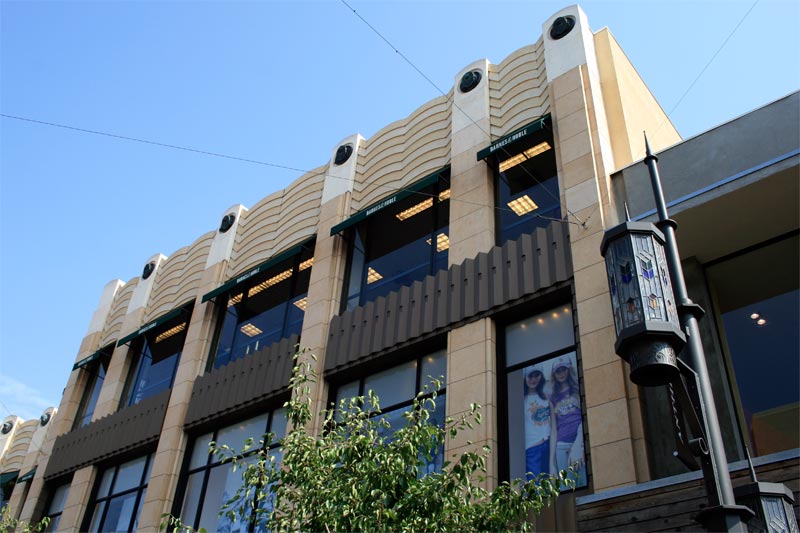After time spent at both the Disneyland Resort and Universal Studio Hollywood, I visited two sister complexes in the Los Angeles area that represent—like Jerde's Citywalk—yet another future trajectory for thematic design.
Both The Grove (2002) and Americana at Brand (2008) are outdoor shopping, dining and entertainment sites designed and built by real estate developer Caruso Affiliated. The firm was founded by Henry Caruso—who also started Dollar Rent A Car—and is currently headed by his son, Rick.
The official inspiration for The Grove, as reported by The Los Angeles Times and elsewhere, is the city of Charleston, South Carolina circa the 1940s. I found this surprising when I read it, because there is a palpable Southern California golden age nostalgia about the place.
However ostensibly based on a real locale in the Southeastern United States The Grove's designers claims it to be, its true lineage is really Disneyland's Main Street U.S.A.
Main Street U.S.A. is the singular entry corridor to Disneyland and a fantastical tribute to Walt's childhood town of Marceline, Missouri. Wrapped in nostalgia and Americana, it was designed to represent the coming of the automobile and electricity (circa 1890–1910). Main Street is not really Marceline at the turn of the century, of course, rather it's sort of a victorian gingerbread anytown (hence the U.S.A. name), and The Grove mimics it in both form and function.
First, the aesthetics—this is not straight simulation, but rather a vision of collective memory; a nostalgia for something that never existed. It's cleaner—no dirt, mud, horse stink (or poverty) and it's also simpler—no differing races, creeds, classes (or crime). This kind of design approach is best described as eliminating visual contradictions.
The use of forced perspective at the very tops of the building facades is slighter than at the Disney Parks, but still perceptible. Even the topmost floors of The Grove are functional, after all, and so must be reproduced at near-full size.
Art Deco flourishes—common to the general time depicted here—abound.
The orientation of the central avenue is nearly identical to that at Disneyland—complete with a trolley car that runs up and down on busy days (it was unfortunately out of service when I visited).
A central plaza and green space sports a water fountain show by WET Design (founded by ex-Disney imagineers) who created the famous fountains at the Bellagio in Las Vegas, countless water features for disney parks and attractions, as well as a similar water show at the new Americana at Brand.
Second, the utility—just as at Main Street U.S.A., lavishly adorned false-front architecture serves as facade for a large retail complex. Inside, all of the businesses at The Grove appear as regular mall outlets and, as at Disneyland, several are interconnected, despite their outer appearances being small, individual proprietorships. In the tradition of Venturi and Brown's "decorated shed;" here, then, is the "decorated mall."
When compared to Jerde's postmodern Citywalk, The Grove is a striking contrast. Instead of a departure from (and an adamant rejection of) Disney's simulation-centric nostalgic representation, The Grove embraces it.
The Grove represents the culmination of an architectural trend that has spread across the United States for several decades, reaching high zenith in the 1990s; one of very consciously manufactured nostalgia instead of overt modernism or flashy pop sensibility.
It's hard to estimate in numbers how influential the Disneyland Main Street model has been; but the influence is certainly there. In the fifty years since Disneyland opened its gates, shuttered downtown districts across the country—decimated by the suburban mall, and later, the big box—have sought to revitalize (and grow their tax base) by gentrifying their own once-bustling Main Streets and taking a page from Disney.
This has extended to the residential sphere as well. Masterplanned communities that wrap themselves not in high-tech gloss or Frank Gehry "starchitecture," but in a re-imagined, pre-war faux-yesteryear have been spreading wildly for over two decades. This neo-traditional neighborhood concept—clearly influenced by the thematic design of Disney and others—is part of the New Urbanism school of architecture that arose in the United States beginning in the 1980s. Prime examples include Seaside, Llorida (where, appropriately, the sterile reality-television town of 1998's The Truman Show was filmed), Prospect New Town, Colorado, and Disney's own Celebration, Florida (designed by Robert A. M. Stern).
The Grove is unique in that it represents the creation of a re-vitalized retro-downtown from scratch, without having actually re-vitalized anything that came before. And like its more recent Glendale sister, Americana at Brand, outdoor decorated malls such as The Grove (and New Urbanism residential developments with a shared vision) signify the growth of thematic design beyond entertainment and leisure.
Whereas before, one experienced a thematic environment for a day (Disneyland) or a series of days on vacation (Walt Disney World); now it's possible to shop, work, and even permanently reside fully encased in the visual narratives of imagined nostalgia. It's theming as lifestyle, and from the suburbs of southern california to the desert daydreams of Las Vegas and burgeoning Dubai—it's on the rise.














